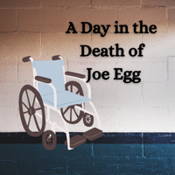
Overview
Synopsis
A Day in the Death of Joe Egg explores the day to day life of a normal family raising their only child, Joe, who is severely disabled. She has cerebral palsy and has been unable to communicate in any way since birth. She uses a wheelchair and has frequent, increasingly debilitating seizures. Her mother, Sheila, gets through each day as they come and still nurses a vague hope that they will find a miraculous cure for her daughter’s illness. However, she often finds her husband’s way of dealing with the situation wearing. Brian is a school teacher who is fed up with his job and fed up with the reality of his tricky homelife. He uses black humor to cope with caring for his daughter. In the first act, we see the brutal reality of Joe’s illness as Sheila and Brian care for their daughter in the evening. The couple reveal how slow the hospital was to diagnose Joe’s illness and then play out the different scenes of condolence in comic routines that they have obviously performed for each other many times before. By Act Two, Brian’s mother and a couple from Sheila’s amateur dramatics group are introduced into the scenario. Their presence and their questions create a new dynamic, in which we see the fantasies and buried anger of a couple struggling to cope with their reality. Peter Nichols wrote the play off the back of his own experiences bringing up a handicapped child, and its treatment of taboos surrounding disability both amuse and shock at the same time.
A Day in the Death of Joe Egg was initially rejected by London’s theatres as being too controversial and it was always banned by the Lord Chamberlain, who still censored all plays at this time. However, it was eventually produced at the Citizens Theatre in Glasgow, before transferring down to the West End and then Broadway in 1968. It is important to note that it was one of the first plays in the 1960s to break the fourth wall and have Sheila and Brian speak directly to the audience.
Show Information
Context
Plot
Characters
| Name | Part Size | Gender | Vocal Part |
|---|---|---|---|
|
Lead |
Female |
Non-singer |
|
|
Lead |
Male |
Non-singer |
|
|
Supporting |
Female |
Non-singer |
|
|
Supporting |
Female |
Non-singer |
|
|
Supporting |
Male |
Non-singer |
|
|
Supporting |
Female |
Non-singer |
Songs
A song with an asterisk (*) before the title indicates a dance number; a character listed in a song with an asterisk (*) by the character's name indicates that the character exclusively serves as a dancer in this song, which is sung by other characters.
Monologues
Scenes
Key Terms
Comedy that treats disturbing or taboo subjects with irony, often found in satire or plays with existential themes.
A motor disability occasionally represented in realistic theatre to highlight lived experiences and challenge audience assumptions.
A neurological condition sometimes portrayed in drama to raise awareness or illustrate physical and emotional challenges.
The imaginary wall separating the audience from the actors onstage, often 'broken' for direct address. This term plays a vital role in understanding theatrical structure and is commonly encountered in stagecraft or performance settings.
Videos
Quizzes
Themes, Symbols & Motifs
Sorry! We do not currently have learning modules for this guide.
Quote Analysis
Sorry! We do not currently have learning modules for this guide.
